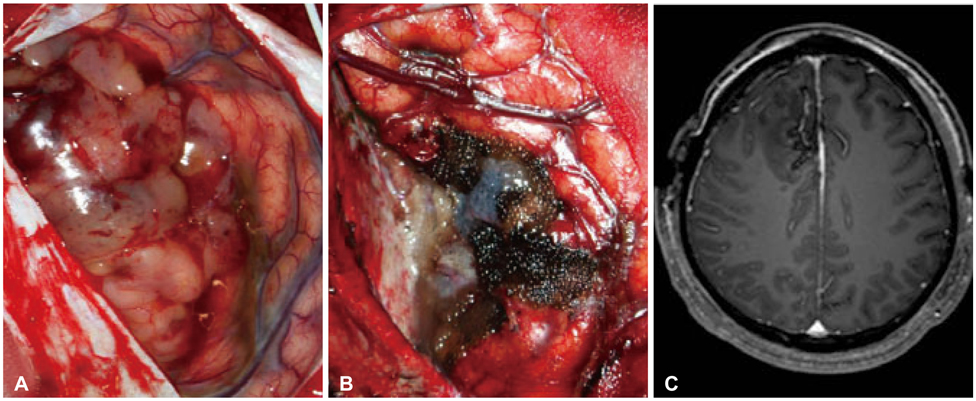Brain Tumor Res Treat.
2013 Apr;1(1):36-41. 10.14791/btrt.2013.1.1.36.
Solitary Primary Leptomeningeal Glioma: Case Report
- Affiliations
-
- 1Department of Neurosurgery, Yonsei University College of Medicine, Seoul, Korea. changjh@yuhs.ac
- 2Department of Pathology, Yonsei University College of Medicine, Seoul, Korea.
- 3Neuro-Oncology Clinic, Yonsei University College of Medicine, Seoul, Korea.
- 4Brain Research Institute, Yonsei University College of Medicine, Seoul, Korea.
- KMID: 2165221
- DOI: http://doi.org/10.14791/btrt.2013.1.1.36
Abstract
- We report a case of solitary primary leptomeningeal glioma. The mass was totally removed under awake surgery. Intraoperatively, no parenchymal involvement was noted. Histopathological study revealed a predominant anaplastic oligodendroglioma component and a focal anaplastic astrocytoma component, which was consistent with an anaplastic oligoastrocytoma. Adjuvant tomotherapy was followed and the tumor has not recurred until 12 months after surgery. A focal type of primary leptomeningeal glioma is extremely rare. We report a rare case of solitary primary leptomeningeal anaplastic oligoastrocytoma.
Keyword
MeSH Terms
Figure
Cited by 1 articles
-
Primary Diffuse Leptomeningeal Gliosarcomatosis
Ju Hyung Moon, Se Hoon Kim, Eui Hyun Kim, Seok-Gu Kang, Jong Hee Chang
Brain Tumor Res Treat. 2015;3(1):34-38. doi: 10.14791/btrt.2015.3.1.34.
Reference
-
1. Kakita A, Wakabayashi K, Takahashi H, Ohama E, Ikuta F, Tokiguchi S. Primary leptomeningeal glioma: ultrastructural and laminin immunohistochemical studies. Acta Neuropathol. 1992; 83:538–542.
Article2. Kalyan-Raman UP, Cancilla PA, Case MJ. Solitary, primary malignant astrocytoma of the spinal leptomeninges. J Neuropathol Exp Neurol. 1983; 42:517–521.
Article3. Opeskin K, Anderson RM, Nye DH. Primary meningeal glioma. Pathology. 1994; 26:72–74.
Article4. De Tommasi A, Occhiogrosso G, De Tommasi C, Luzzi S, Cimmino A, Ciappetta P. A polycystic variant of a primary intracranial leptomeningeal astrocytoma: case report and literature review. World J Surg Oncol. 2007; 5:72.
Article5. Cooper IS, Kernohan JW. Heterotopic glial nests in the subarachnoid space; histopathologic characteristics, mode of origin and relation to meningeal gliomas. J Neuropathol Exp Neurol. 1951; 10:16–29.
Article6. Keith T, Llewellyn R, Harvie M, Roncaroli F, Weatherall MW. A report of the natural history of leptomeningeal gliomatosis. J Clin Neurosci. 2011; 18:582–585.
Article7. Horoupian DS, Lax F, Suzuki K. Extracerebral leptomeningeal astrocytoma mimicking a meningioma. Arch Pathol Lab Med. 1979; 103:676–679.8. Thomas JE, Falls E, Velasco ME, Zaher A. Diagnostic value of immunocytochemistry in leptomeningeal tumor dissemination. Arch Pathol Lab Med. 2000; 124:759–761.
Article9. Bailey P, Robitaille Y. Primary diffuse leptomeningeal gliomatosis. Can J Neurol Sci. 1985; 12:278–281.
Article10. Scully RE, Galdabini JJ, McNeely BU. Case records of the Massachusetts General Hospital. Weekly clinicopathological exercises. Case 17-1978. N Engl J Med. 1978; 298:1014–1021.
- Full Text Links
- Actions
-
Cited
- CITED
-
- Close
- Share
- Similar articles
-
- Primary Diffuse Leptomeningeal Gliomatosis: Report of a Case Presenting with Chronic Meningitis
- Response of Leptomeningeal Dissemination of Anaplastic Glioma to Temozolomide: Experience of Two Cases
- The Clinical Features of Spinal Leptomeningeal Dissemination from Malignant Gliomas
- Primary Diffuse Leptomeningeal Gliosarcomatosis
- Leptomeningeal Dissemination of a Low-Grade Brainstem Glioma without Local Recurrence





